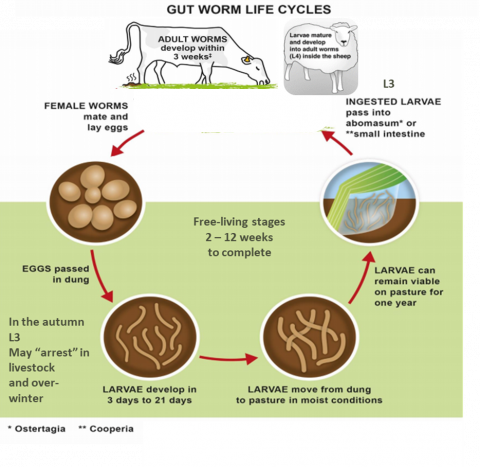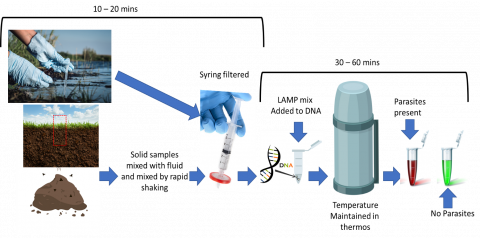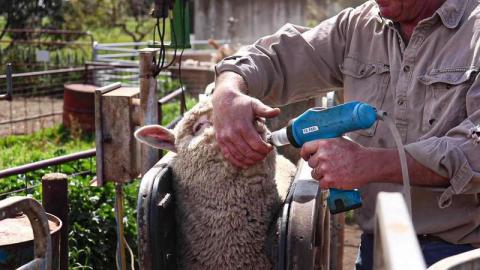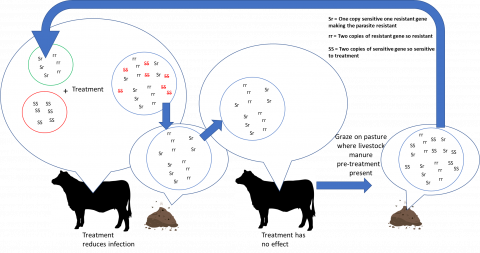17 June 2021
Dr David Cutress & Dr Gwen Rees: IBERS, Aberystwyth University.
- Gastrointestinal nematodes (GINs) are highly prevalent in the UK cattle industry
- GINs can have implications on cattle health, welfare, productivity, and economics, particularly in youngstock due to lack of immunity development and smaller size
- Best practices exist to improve/control these parasites and are vital as environmental shifts change the prevalence and persistence of parasites in the UK
Introduction
Gastrointestinal roundworms/nematodes (GINs) are a group of parasites of the nematoda phylum that fall within a group of organisms commonly referred to as helminths, which also includes fluke worms. These worm-like parasites play key roles in both human and animal infections and disease and are present across all known livestock species. Whilst GINs are largely considered more of a risk in sheep farming in the UK, due to increased severity of disease and increased likelihood of mortality, they are also a concern in cattle. One factor for the increase in mortality and severity in GIN infected sheep as opposed to cattle is due to the relative animal size, requiring higher parasite numbers for cattle to be equivalently affected. As such, growing youngstock are at higher risk than adult cattle.
Two of the main genera of GIN with high prevalence in cattle are Cooperia and Ostertagia with Ostertagia ostertagi, the brown stomach worm, and Cooperia oncophora, an intestinal worm, being the most prevalent species in the UK. These share the same life cycle where L3 larvae are ingested by livestock from pasture and develop into adult worms in the gastrointestinal tract. Inside they directly compete with the animal for nutrients, and/or they can actively feed on or damage the animal itself via blood and tissues interactions. Certain species can arrest their development over winter to hibernate in the stomach wall or on pasture which has implications on pasture and housing re-infection risks. Currently, in the UK it is suggested that the prevalence of O. ostertagi alone across dairy farms is 95% based on bulk milk sample antibody testing, demonstrating just how significant this species is within the cattle sector.
General gastrointestinal worm life cycle in ruminant livestock adapted from COWS and SCOPS.org
Why be concerned?
Health, welfare and productivity
Gastroenteritis, the condition associated with infection by GINs, is associated with symptoms such as diarrhoea, weight loss and loss of appetite. Symptoms relate to a redirection of nutrients in animals, with studies of calves infected with Cooperia finding that uninfected controls gained weight 7.5% faster and that infected calves’ appetite was reduced by 0.68 kg per day. Young calves specifically are noted to have particular susceptibility to enteric gut infections and take time to develop a natural immune response to GINs. This can be an issue in the second season grazing as a lack of parasite challenge following treatment and no exposure over winter can make youngstock more susceptible again to reinfection. Other impacts of parasite burden in the cattle industry include the reduced production of milk, meat, hides, skins and implications in reproductive success.
Economic impacts
Parasites can have huge economic and welfare burdens on many agriculturally important animal species. A combined economic analysis of the impact of multiple parasitic species (including nematodes but also cestodes, protozoa and trematodes) suggested that the average impact on cattle was a decrease in milk production of 1.16 litres a day, 12.95% of organs being condemned at slaughter and losses of productivity which equated to around 17.94% of total farm losses or around £36.44 per animal per year. Considering 2020 UK figures for cattle numbers were 9.36 million in December (with cattle under 1 year making up over 25% of this) this equates to an annual potential loss of approximately £341 million if all cattle were affected by parasites and potential risk of £85.25 million for youngstock.
Resistance development
Although there is economic/geographic polarisation concerning the impact of parasites, the developing evidence of resistance to anti-parasitic drugs - especially in helminth species over the last decade - suggests that both the developed and less-developed world will have similar parasite problems concerning food security shortly. Despite this, in a recent review of literature, only 18 out of 40 of the shortlisted papers had looked at anthelmintic use or resistance in livestock and of these only 3 focused on cattle specifically, with a much larger focus on sheep. Resistances were indicated solely to macrocyclic lactones in the UK across multiple farms, however, grey (non-peer reviewed) literature indicates the potential of resistance to other anthelmintic groups within the UK being likely.
Climate change
Climate change is another factor that could well be driving the negative economic and health impacts of parasitic diseases. Climate modelling indicates a spread of parasitic diseases and changes in UK parasitic disease patterns. Disease pattern effects are associated with geographical changes in weather patterns altering the environment of both the parasite and its hosts. If this is not monitored carefully it could impact how effective current treatment strategies are, as parasite activity throughout a year fluctuates (eg. GINs becoming more active in late winter). An example of this can be seen in reports from Northern Ireland where it was found that whilst previous research indicated nematode eggs required chilling (simulating overwintering conditions) to hatch, 43% were now able to hatch without this, indicative of adaptations to increasing global temperatures. There is also evidence of more tropical helminth species spreading further north and south to take advantage of niches that were previously uninhabitable, which could mean farmers face new threats if these trends continue.
Diagnosis and treatment strategies
Despite the concerns noted above, the use of best practice parasite control and advice from anthelmintic prescribers on treatment and management is reduced in cattle farming compared to sheep farming. Whilst adult cattle may often appear unaffected by parasite burden, it is known that subclinical effects can negatively impact health and productivity. As such, cattle farmers are advised to consider GIN diagnosis and treatment strategies more seriously.
The mainstay diagnostic tool across GINs involves faecal egg counting (FEC), which are relatively cheap and easy to perform. FECs are more consistently useful in sheep and horses, however, there is ongoing technological development to remove some elements of subjectivity for increased accuracy in cattle. Whilst FEC offers a tool to determine infection in general as well as identifying the species involved to improve treatment specificity, it can be labour intensive to perform collections on individual animals so generally herd-level testing is used. Furthermore, egg numbers do not always accurately reflect the level of infection, there can be a time delay between active egg shedding and clinical signs and the larger dung pat sizes in cows than sheep can dilute the accuracy of FEC. Molecular tools such as ELISAs (Enzyme-linked Immunosorbent Assays) are an alternative for determining infections via faecal, blood, saliva or milk samples but these tend to be more expensive and sensitive to contamination errors on sample collection. Key benefits to ELISAs, however, are that they can detect stages of parasites that aren’t currently actively producing eggs with the potential to diagnose earlier or during hibernating phases, as well as being able to indicate infection levels in the animal.
Due to the economic cost and potential for the development of resistance associated with mass treatment for gastro-intestinal nematodes as well as fluke parasites, there is an increasing interest in performing targeted treatment management strategies based on individual animal diagnostics results. A simplistic possibility for monitoring individual animals is through monitoring animal weight accurately. With the ability to digitally weigh and store animal weights based on EID identification now easier than ever, this approach could have the potential to improve monitoring and treatment on farms. Studies specifically looking at animal weights compared to parasite infections have suggested up to 76% accuracy in treating infected animals via their average daily weight gain figures at the end of the season. Furthermore, other nutrient deficiencies and diseases can also be detected by weighing animals more regularly, making it a good holistic health-monitoring option for farmers.
Other tools with potential for improving GIN diagnosis include behavioural monitoring sensors which monitor animal movement on collars and tags which have become less expensive and more viable on farms. Work is ongoing which suggests that changes in day and night activity levels in young cattle seem to correlate well with their level of infection, which could provide extra functionality to systems that can already monitor health, oestrus, lameness and calving for example.
Tools in development
A molecular tool of growing interest for diagnosis and potential environmental risk detection is environmental DNA. Environmental DNA (eDNA) is present in reservoirs in the environment including water, air and sediment and capturing this DNA can allow its use in identifying the presence and species of parasites for more targeted treatment. This is an element that is currently being explored in Farming Connect’s EIP project on fluke parasite mapping which will be discussed in a future article. Whilst this is a far more complex diagnosis/detection method than FECs, there is research on its combination with a technology known as loop-mediated isothermal amplification (LAMP) which could allow in-field testing due to results being compatible with a simple colour change output within 30 – 60 minutes. Whilst other DNA isothermal amplification techniques can and are already utilised to diagnose infections (with some able to diagnose between multiple parasite species in a single test) these currently require a significant level of laboratory preparation and equipment and are more feasible for significantly intensive systems or long-running, difficult to diagnose problems.
It is clear that no single diagnostic tool offers everything required for fully accurate targeted treatment, there are trade-offs in costs, availability, accuracy and information provided. An improved situation would be to utilise broader, simple diagnostic tools such as FECs along with more specific, individual animal data such as regular weighing or behaviour sensors and utilising this combined data to make well-informed decisions.
Treatment
The use of anthelmintics to treat GINs in cattle should always be part of a control plan. As the situation on each farm is unique, parasite control plans should always be designed in consultation with the farm’s veterinary surgeon who can advise on the best options. Where anthelmintic treatment is required as part of a parasite control plan, there are three main classes of anthelmintics that treat internal parasites in cattle in the UK. These are benzimidazoles (BZ - White), macrocyclic lactones (ML - Clear) and Levamisoles (LV - Yellow). Each class has different parasite group specificities, and differing levels of resistance worldwide. Treatments range from injectables, pour-ons, boluses and drenches, with scheduled seasonal treatment regimes being common to match parasite species’ changing prevalence. Guides for best practice for treatment application, including accurate weighing of animals for correct dosage and maintaining the calibration of dose guns to ensure dose consistency, can be found on the AHDB, SCOPS and COWS websites. Despite this, inappropriate use of treatments is common. Inappropriate use of anthelmintics is known to encourage the development of resistance. Problems include using the wrong treatment (eg. ivermectin for liver fluke), under- or over-dosing due to lack of accurate animal weighing as well as over-reliance on prophylactic anthelmintic use instead of targeted, seasonal control plans. Recent advances aimed at improving dosing include systems that can remove some of the labour involved with weight-based dosing by linking digital weigh scales to digital dosing guns which have the potential to be a key tool for responsible and effective parasite control on farms.
Digital wight scale and digital dose adjustment gun - Image is taken from tepari.com
Sustainable control potential
Anthelmintic resistance is a growing concern amongst all livestock species and as such is a core part of the Welsh Governments antimicrobial resistance implementation plan as well as a key global consideration. Methodologies utilised for assessing resistance in parasites include faecal egg count reduction tests (FECRT), larval development tests (LDT), egg hatch tests and self-reporting by farmers. Improving awareness of the challenge of anthelmintic resistance, and developing knowledge of monitoring options amongst farmers is key to promoting a more sustainable approach to parasite control.
The use of anthelmintics is one part of a range of measures that can be used to manage parasite burden in livestock. Aside from chemical drug treatments, the sustainable control of parasites in livestock requires other control and treatment strategies. These may reduce environmental impacts associated with potential polluting releases of chemicals, as well as minimising parasite-associated productivity losses leading to decreased GHG per kg product. These include:
- Grazing management considerations, particularly surrounding rotational grazing strategies were fresh fields can be grazed to avoid infection risks during key GIN development seasons and fields at rest can prevent larvae from having hosts.
- Optimising stocking density, as studies of youngstock have indicated a relationship where higher stocking densities are linked to higher pasture contamination.
- Mixed-species grazing has been indicated to play a role in lowering overall pasture burdens and the decontamination of fields.
- Sufficient quarantine of new stock following drench or FEC analysis.
- Mechanical removal of dung could have potential in managed pastures with reduced labour if automated technologies were developed to facilitate this.
- Feeding condensed tannins and other medicinal grazed plant contents have shown some potential and further research is ongoing.
- Integrated parasite management (IPM) via biological controls such as dung beetles or encouragement of nematode-trapping fungi by adding spores to feed, reducing survivability of larval stages in dung.
- Genetics is another area where parasite control could be considered more sustainably (though the research itself has a carbon footprint associated). Targeting key genes and key regions in genes, modified via selective breeding or gene-editing techniques, could improve the parasite resistance of animals. Some genes have been indicated to play roles that could improve animal productivity and reproduction at the same time.
- Parasites in refugia is a key concept in control which involves introducing non-resistant organisms or maintaining some non-resistant populations to avoid creating populations of solely resistant parasites.
Summary
GINs are a significant problem within the agricultural sector having huge productivity and economic impacts. Whilst cattle farmers tend to feel fewer impacts, subclinical effects, as well as susceptible youngstock, should be considered carefully. Awareness and diagnosis of parasites in a herd is key to starting to tackle the productivity and health issues these can cause. As such, incorporating consistent routine use of simpler techniques such as FECs, as is being performed and validated specifically in youngstock cattle by the Farming Connect EIP project alongside Techion, should help to improve treatment efficiency. There is also the potential for combining diagnostic techniques to gain an even clearer picture of parasite burden across farms and on a per animal basis. Whilst anthelmintic drugs are beneficial when used correctly and in a targeted way, many other more sustainable worm control methods are also available and could well benefit farmers in multiple ways if integrated into management systems.




